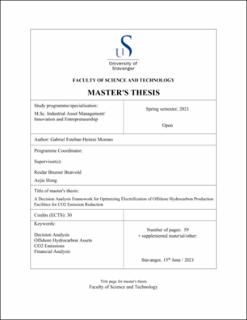| dc.description.abstract | The oil and gas industry has been increasingly focusing on sustainability and emissions in their offshore production facilities, where 80% of emissions come from the generation of electricity for powering their platforms (AkerBP 2020a). Electricity is commonly generated through the use of inefficient gas turbines equipped on the offshore facilities.
In this thesis, a Multi Attribute Decision Analysis (MADA) framework is developed to support the decision on which electricity generation technology should be used to reduce CO2 emission in an economically viable manner.
The MADA framework consists of three phases, namely: structuring, modeling and finally assessing and deciding. Within the structuring phase we defined the decision context and its core objectives, namely: maximizing net present value (NPV) and minimizing lifecycle CO2 emissions of new offshore electricity generation technology (Bratvol & Begg, 2010 ).
A small field with a reserve of 50.7 MMbbl in the Norwegian Continental Shelf is used as a case study. Within the modeling phase, a Monte Carlo simulation is performed to assess the uncertainties in the Net Present Value (NPV) and lifecycle CO2 emissions of each alternative - no change (i.e., the base case), offshore wind turbine integration, new (more energy-efficient) gas turbine integration, and power from shore (onshore electricity supply).
The Monte Carlo analysis yielded an average NPV of $134.7 million for the wind turbine integration alternative, $101.4 million for the new gas turbines alternative, $89.9 million for the base case analysis and $-1.8 million for the power from shore alternative. The lifecycle CO2 emissions for the alternatives are 0.06 million tonnes (power from shore), 0.15 million tonnes (wind turbine integration), 0.2 million tonnes (new gas turbines), and 0.3 million tonnes (the base case). We conclude from our multi attribute decision analysis that, in general, the best alternative is the offshore wind turbine integration, given a higher weight is set on maximizing NPV. The sensitivity analysis on reserves indicates that the new gas turbine integration alternative is the best for a field with a reserve of greater than 253.5 MMbbl. The sensitivity analysis on the weighting of objective attributes shows that the power from shore alternative is the best when the objective of CO2 reduction has a higher priority (i.e. a greater normalized weight at 0.82) than the NPV maximization. The results from the multi attribute decision analysis generate useful insight on the economic and environmental effects that an oil and gas operator should consider with changing priorities (NPV vs. CO2 emissions) to conform with shareholder opinion and governmental policy when looking for sustainable development and production on new and existing hydrocarbon fields.
This thesis also highlights the importance for considering a wide range of creative alternatives before field development that can be extended in future works. In retrospect, future works can also explore a broader variety in analysis techniques, models, alternatives and scopes, to increase insight on field-specific infrastructure decisions, and understanding their economical and environmental impact. | |
